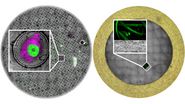Software-controlled pulse evaporation
However, this method applied for carbon layers has some downsides. The heat and light generated from carbon evaporation can influence the frequency of the quartz. Only after some time can a stabilised value give a reasonable thickness measurement. Figures 1 and 2 illustrate how the evaporation process influences the frequency of the quartz crystal over time. Flash evaporation burns the complete thread with full power. Pulse evaporation is performed with a short defined voltage to deposit a small amount of carbon material. Flash evaporation gives a thicker ultimate layer but the result is only defined by the thread section. During a flash evaporation, a considerable amount of heat is generated onto the sample. Using pulse evaporation, the applied layer is defined by the power per pulse, the pulse time and the number of pulses. The heat generated during pulsing is lower than during a flash evaporation.
The innovative method of software-controlled pulse evaporation of carbon thread (developed by Leica Microsystems for the new range of Leica EM ACE coaters) simplifies the previously complicated process. After each defined short pulse the applied thickness is measured. Information is fed back to the process control and a further pulse is performed or the coating successfully completed. For the first time this method is highly accurate, creating thin layers of 1 or 2 nm thickness and reproducible without a high level of experience.
Thickness assessment without a quartz crystal
If one would like to assess the thickness of a carbon layer but a quartz crystal measurement system is not available, there is an easy visual test. Also for reference tests it is a very useful method.
Carbon evaporated onto a gold plated cover slip or test foil (aluminum) shows significant difference in colour according to the thickness (see scale below). The cover slip or test foil is sputter coated with about 50 nm of gold or until it looks completely golden. The image shows golden cover slips coated with carbon in different thicknesses. From left to right: Gold without coating, then starting with 10 nm steps of 5 nm up to 40 nm carbon coating.
Principe of visual test of the thickness of a carbon layer on a gold platet test foil by comparing the color:
This is a simple test if you don’t have a quartz measurement available, however it will not compensate for the strength of a quartz measurement system. The layer thickness is evaluated after the coating process is finished. Therefore it cannot be used for feedback during the coating process. Obviously it is a rough evaluation with an accuracy of +/– a few nanometres. It cannot give nanometre accurate information about the deposited carbon layer and reproducibility is not given. With the integrated pulsed measurement reproducibility is ensured in a range of +0,5 nm.










